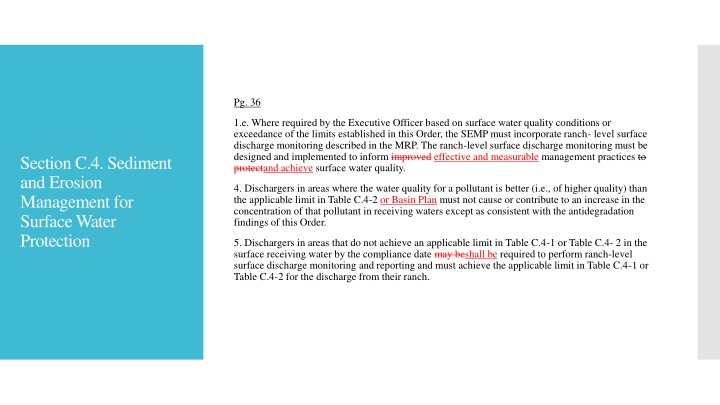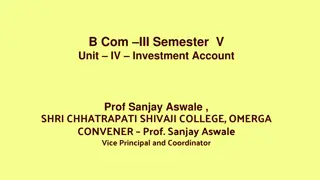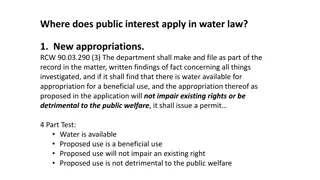
Water Quality Management Requirements for Ranches
Explore the regulations for ranch-level surface discharge monitoring and compliance with water quality limits to protect and improve surface water quality. Learn about sediment and erosion management practices, prohibited discharge of pollutants, and follow-up implementation plans for surface water protection.
Download Presentation

Please find below an Image/Link to download the presentation.
The content on the website is provided AS IS for your information and personal use only. It may not be sold, licensed, or shared on other websites without obtaining consent from the author. If you encounter any issues during the download, it is possible that the publisher has removed the file from their server.
You are allowed to download the files provided on this website for personal or commercial use, subject to the condition that they are used lawfully. All files are the property of their respective owners.
The content on the website is provided AS IS for your information and personal use only. It may not be sold, licensed, or shared on other websites without obtaining consent from the author.
E N D
Presentation Transcript
Pg. 36 1.e. Where required by the Executive Officer based on surface water quality conditions or exceedance of the limits established in this Order, the SEMP must incorporate ranch- level surface discharge monitoring described in the MRP. The ranch-level surface discharge monitoring must be designed and implemented to inform improved effective and measurable management practices to protectand achieve surface water quality. Section C.4. Sediment and Erosion Management for Surface Water Protection 4. Dischargers in areas where the water quality for a pollutant is better (i.e., of higher quality) than the applicable limit in Table C.4-2 or Basin Plan must not cause or contribute to an increase in the concentration of that pollutant in receiving waters except as consistent with the antidegradation findings of this Order. 5. Dischargers in areas that do not achieve an applicable limit in Table C.4-1 or Table C.4- 2 in the surface receiving water by the compliance date may beshall be required to perform ranch-level surface discharge monitoring and reporting and must achieve the applicable limit in Table C.4-1 or Table C.4-2 for the discharge from their ranch.
Pg. 37 6. The discharge of pollutants from a ranch in excess of the applicable limits after the compliance date in Table C.4-1, or Table C.4-2, or the Basin Plan is prohibited and shall result in ranch-level surface discharge monitoring and reporting, and may result in additional requirements, including obtaining additional education, implementing additional or improved management practices, follow-up monitoring and reporting, ranch-level surface discharge monitoring and reporting, the prohibition of discharge from the ranch, and progressive enforcement actions. Section C.4. Sediment and Erosion Management for Surface Water Protection 11. Dischargers must develop a follow-up surface receiving water implementation work plan, either individually or through a cooperative program approved by the Executive OfficerBoard, as described in the MRP. The work plan due date is based on the Surface Water Priority of the ranch. The work plan must include follow-up actions, such as outreach, education, and management practice implementation, and, where applicable for pollutant source identification and abatement, additional surface receiving water monitoring locations. The work plan must include a SAP and QAPP. The work plan must describe the implementation measures that will be taken to reduce the discharge of relevant pollutants and achieve the applicable surface water limits by the compliance dates in Table C.4- 1, or Table C.4-2, or the Basin Plan. The work plan must be submitted for Executive Officer review prior to implementation. Once approved, the work plan must be implemented.
Table C.4-1 2022 2023 2026 2029 2032 2035 2038 2041 2044 2047 2050 2053 Morro Bay Sediment TMDLA Where are you today? 6,652 Tons XX XX XX XX 3,326 XX XX XX XX XX Pajaro Watershed Sediment TMDL Where are you today? 4114 Tons 2,057 Same General Turbidity Warm Where are you today? 20 NTU 40 NTU Same General Turbidity Cold Where are you today? 12.5 NTU 25 NTU Same Section C.4. Sediment and Erosion Management for Surface Water Protection
The minimum vegetated setback from any water, including ditches, must be at least 50-feet. A durable stubble, planted annually is acceptable as a vegetation and can be used for light or infrequent operations. The setback cannot be sprayed, including spot-treatments with herbicides. Section C.5. Riparian Area Management for Water Quality Protection The grass cannot be mowed less than 8 inches high. The setback cannot be overused, creating bare areas or extensive road- tracks (any lightly used road should use the crop side 15-foot margin of the setback). The setback should be planted or seeded at moderate to high density in the fall; some re-seeding may be necessary in the spring to fill in any bare spots.
Pg. 42 4.b. The operational setback distance must be either 1) 1.5 times the width of the active channel, on each side of the stream, or shall not be less than 35 50- feet wide measured from the crop margin towards the for waterbodies waterbody. that are not streams such as wetlands and lakes; or 2) The applicable riparian setback, if required, can include up to a 50-foot vegetated operational setback on the field-side of the riparian setback. the applicable riparian setback9 distance in Table C.5-1 (and Table C.5-2, where applicable), whichever is less. Proposed Riparian Area Amendments Pg. 43 9. The introduction of invasive species in the minimum riparian setback and operational setback is prohibited.
Order of Stream Minimum Operational Set Back (ft) Riparian Setback (ft) Min Multi- Benefit Riparian Vegetation (columns 3 2) Stubble or low dense vegetation Native vegetation 5+ incl trees Ditches & order 1 50 0 0 Table C.5-1 Replacement Order 2 50 75 25 Order 3 & 4 50 100 50 Order 5+ 50 200 150 Wetland area < 10 50 0 0 Wetland 10-100 35 70 35 Wetland 101-350 50 125 75 351 or greater 50 175 125
Encourage Innovative Solutions Alternative Compliance Scheme Limit Burden on Board Members & Staff Maintain Water Quality Protections
The Executive Officer may approve an alternative compliance option for one-off individual situations. The Executive notice on matters related to Agricultural Operations on the Central Coast. Officer may approve alternative compliance options for third-parties, groups, or groups of individuals if the following conditions are adhered to: Third-Party Coalitions shall not be allowed to approve alternative compliance proposals. Proposed alternative compliance options to be approved pursuant to the Executive Officer s delegated authority shall be posted for public comment for a period of thirty days and circulated to persons who have requested public notice on matters related to Agricultural Operations on the Central Coast. Recommended Alternative Compliance Scheme When appropriate, the Executive Officer is encouraged to group similar alternative compliance pathways into one public comment period to streamline the approval process and reduce resource burdens on staff and Board Members. After considering the public comments received on a proposed alternative compliance option, if a compliance option is protested or a significant controversy arises during public comment, the final approval of the alternative compliance option shall be made by the Regional Water Board at a public meeting. In circumstances where the alternative compliance option will be used by, or impact, five or more growers, the final approval of the alternative compliance option shall be made by the Regional Water Board at a public meeting following a public comment period. Three years from the adoption of this Order, the Regional Board shall conduct a comprehensive review of the alternative compliance options and approval process. The Executive Officer will submit findings and program recommendations for public comment, and recommended changes to the alternative compliance process will be approved by the Regional Water Board.
Growers with alternative compliance options must be required to continue to monitor as required by the Order. Monitoring Alternative Compliance All growers should pay a fair share towards receiving water monitoring. Requested Amendment: Pg. 16,12.Dischargers or groups of Dischargers seeking regulatory requirements tailored to their specific operation, ranch, geographic area, or commodity may submit an ROWD to obtain an individual order or MRP, or request the development of a general order for a specific type of discharge (e.g., commodity-specific general order). Dischargers covered by alternative orders will be required to continue paying a fair-share fee in support of surface and groundwater monitoring.






















